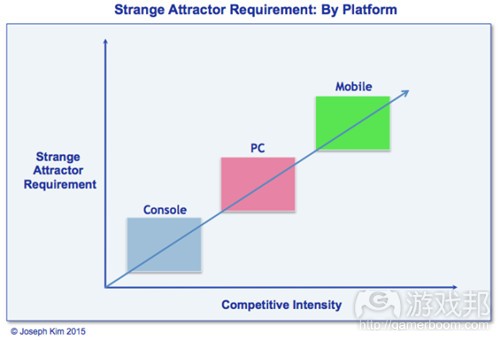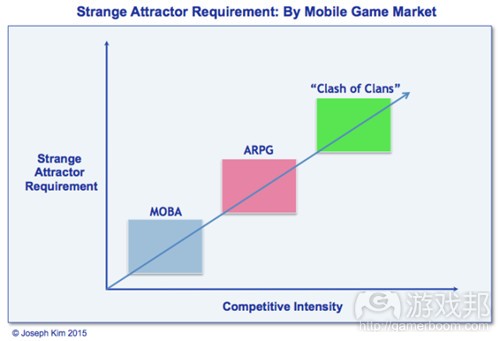电子游戏设计中的“特别的吸引元素”
作者:Joseph Kim
背景
在游戏玩法,机制,盈利或任何其它关键的设计考虑因素前,全新的电子游戏设计需要考虑的最重要元素是:一个优秀的概念。
电影编剧Terry Rossio创造了“特别的吸引元素”这一概念去帮助其他编剧理解如何为电影观众创造吸引人的电影理念。来自Writing Excuses的作者们为了书籍而进一步调整并优化了这一概念。Rossio表示:“通常情况下,编剧在一开始所选择的最佳形式的概念并不是能够出售给好莱坞的故事类型。”
电子游戏(与电影和书籍一样)只是特别的吸引元素原则所执行的另一种娱乐媒体罢了。在本文中我将:
1.解释什么是“特别的吸引元素”
2.呈现使用这种元素的电子游戏的例子
什么是“特别的吸引元素”?
Terry Rossio(在他的网站上)如下描述特别的吸引元素:
将“特别的”(表示“与众不同的”)与“吸引元素”(表示“吸引人的”)结合在一起你便能够得到“特别的吸引元素”或“一些独特同时也吸引人的内容”。
肯定存在一些吸引人,诱人且有趣的元素。
你可以将其称为圈套或花招。在好莱坞人们有时候还会将其称为“高概念”—-一个电影理念并且能够以一或两句话陈述出来。
你最好能够为你的电影设计一个吸引元素。你需要清楚它是什么。你应该能够指出它并描述它,即与你描述角色,主题和情节的方式一样。
特别的吸引元素的原则在于你需要提供给用户一些他们能够轻松理解并且会被吸引去尝试的内容。不管是电影,书籍还是游戏,最初的吸引元素都需要能够让用户愿意给产品一个机会。
在免费游戏领域,这一原则特别重要:
市场营销:最初在没有吸引人的概念时吸引用户转换的市场营销(较低的点击率)
用户留存:用户在快速玩了一轮游戏后不能看到明显的区别或找不到继续留在游戏中的动机时的整体用户留存
LTV:较低的用户留存会影响用户终身价值(LTV)从而降低整体的游戏经济
特别的吸引元素公式:普通+特别
来自Writing Excueses的作者将特别的吸引元素总结为“普通”与“特别”的结合。就像Writing Excuses的Howard Tayler说道:
将一个非常平凡的理念与一些非常特别的内容整合在一起。
让我们列举Writhing Excuses的作者在小说中所提到的一些例子:
1.关于高中的故事,这通常都是日本漫画的设定。这是一个让人熟悉的地方:“可能与你相关的一些事,可能已经出现在你的脑海中的一些东西。”但是之后你可以添加一些特别的部分,如老师是个外星人或机器人。
2.“关于连接着宇宙的虫门运输系统的理念便非常特别,但现在这却成为了一种非常普通的理念。当我认为这种运输系统复制了人类的运输系统或有人滥用这种方式时,我可能会再次想出其它特别的理念。”
此外,Writing Excuses团队还提到了一些其它的看法:
1.类型发展:在今天我们觉得奇怪的一些理念在明天可能会突然普及起来。创造者需要牢记“新颖的内容变得泛滥”的时刻。
2.不同的期待:基于不同产品类别或类型,人们对于熟悉与陌生的期待值也是不同的。例如在小说中,浪漫主义书籍的读者想要看到99%不变的内容。而漫画书读者可能想要70%熟悉的内容与30%特别的内容。科幻小说读者则会期待70%的新内容与30%熟悉的内容。
3.了解你的用户:因为不同用户拥有不同的期待,所以你需要去了解你的市场并清楚他们所期待的普通vs特别的比例。同时你还要随着市场的发展去预见什么是用户所熟悉的内容与陌生的内容。
电子游戏中的特别的吸引元素
所以在游戏中是怎样的?
如果能够理解另一个问题,即竞争强度的影响,那么特别的吸引元素原则与游戏的关系便会变得更清楚。
例如,基于竞争强度,不同平台对于特别的吸引元素的需求也会不同:拥有无数手机应用的应用商店vs每年发行相对较少游戏的主机意味着主机游戏能够引起更多个体关注。因此手机游戏对于特别的吸引元素的要求便会更高。如下:
此外,说到手机游戏平台,我们要做到每个游戏市场都拥有不同水平的竞争强度,例如,因为市场上的MOBA(游戏邦注:像《英雄联盟》等多人在线竞技游戏)不多,因此这类型游戏并不需要像《部落战争》游戏那样要求较强大的特别的吸引元素。
手机游戏案例
接下来让我们看看一些实际的特别的吸引元素案例。当下的一个典型例子便是Big Huge Games刚刚发行的《DomiNations》。从表面上看,这款游戏只是《部落战争》的复制品,但是Big Huge 团队却通过并置《部落战争》游戏玩法(普通)与《文明》的时代进化理念(特别)而创造出一款具有吸引力的作品。
在游戏中,我们不仅需要在产品的市场营销中传达特别的吸引力,同时也要在最初的游戏体验中传达这样的吸引力。
看看下图的《DomiNations》的HUD:
用户可以马上辨别出它与《部落战争》的区别:美术风格,道路,捕猎与采矿,守卫,资源,建造浇注系统,以及市政厅的发展进程。所有的这些内容都为游戏添加了独特性,并让用户能够将其与其它游戏区分开来。再一次地,这也是创造具有竞争力的游戏类型的关键。
要点:用户必须能够快速且轻松地理解其中的区别。
没有特别的吸引元素的例子
IGG的《领土战争2》是一款带有优秀的游戏玩法的游戏,但是我认为因为缺少强大的特别的吸引元素,所以它很难吸引用户的注意。实际上,IGG发行了两款类似《部落战争》的游戏:《城堡争霸》和《领土战争2》。然而IGG通过《城堡争霸》获得了成功也因为《领土战争2》遭遇了失败。
到底发生了什么?
IGG发行了一款类似《部落战争》的小游戏,不过他们较早便做到了这点(即在《部落战争》发行1年后),并且是作为第一款在游戏玩法中添加了英雄单位的游戏。《城堡争霸》发行于2013年10月,其强大的游戏玩法便足以帮助游戏获得较大的吸引力并挤进当时畅销游戏排行榜的前50名。然而在《城堡争霸》发行1年后,IGG又发行了《领土战争2》。这时候冲突游戏玩法和英雄概念已经非常普及了。所以《领土战争2》很难再得到较大的关注,即使它拥有比《城堡争霸》更出色的游戏玩法(例如战斗中活跃的技能,英雄军队单位,英雄gacha机制等等)。
为什么?
就像你在之前看到的,这两款游戏看上去非常相似:不管是颜色,美术风格还是UI结构。不幸的是对于IGG来说,游戏玩法的区别并不能快速吸引全新的游戏玩家。实际上,一些新玩家并不能理解游戏真正吸引人的地方,并且他们面前还有无数待选择的复制品。因此尽管作为一款更出色的游戏,但是缺少特别的吸引元素便是它未能取得商业成功的关键原因。
在传统的电子游戏中
在主机游戏中我们发现对于特别的吸引元素的需求较少,因为每一年出现在主机上的游戏并不是特别多。一般说来,主机游戏的竞争是基于制作价值(如图像),品牌,故事和有经验的团队/开发者(如Bungie/Kojima)。然而即使在这一领域,我们也能看到许多因为特别的吸引元素而获利的游戏:
《侠盗猎车手》
普通:典型的行动冒险游戏玩法,人们所熟悉的城市
特别:你将成为一个坏人
《古墓丽影》
普通:典型的行动冒险游戏玩法,《夺宝奇兵》式的背景设定
特别:以性感的女性作为主角
《生或死》
普通:典型的对抗游戏玩法
特别:“Boob”技术,大量使用大胸的女性角色
在PC游戏领域,我们能够看到更多出色使用特别的吸引元素的游戏,但我认为开发团队应该在开发游戏前更认真地思考这一概念。
让我们以开放世界生存恐怖游戏中不具有明确概念区别的游戏为例:《DayZ》,《Rust》,《H1Z1》,《森林》,《暗夜求生》,《Frozen State》,《消逝的光芒》等等。当更出色的竞争者进入市场时,用户将不会再关心你的新游戏机制多厉害,而是会专注于特别的吸引元素。
结论
任何想要在高度竞争的游戏类别中赢得竞争的人都需要考虑游戏的特别的吸引元素。设计师也需要了解他们的市场和用户。对于特殊的游戏类别,你们需要问自己这些问题:
怎样的普通vs特别的比例最合适?
这一类型的独创性是什么?
什么时候特别的全新理念会变得过时?
对于那些能够贯穿任何平台(游戏玩法风险通常已经得到了化解)去考虑竞争性游戏类别并选择能够引起新玩家关注的特别的吸引元素的聪明开发者总是能够赢来属于自己的机遇。
在你开始全新游戏项目前请先问问自己:我的游戏的特别的吸引元素是什么?
(本文为游戏邦/gamerboom.com编译,拒绝任何不保留版权的转发,如需转载请联系:游戏邦)
The “Strange Attractor” in Video Game Design
by Joseph Kim
Context
Before gameplay, mechanics, monetization, or any other key design consideration, a new video game design needs to consider the most important aspect of all: a good concept.
Feature film screenwriter Terry Rossio (credits include Shrek, Pirates of the Caribbean, Aladdin, and many others) developed the notion of a “Strange Attractor” to help other screenwriters understand how to create compelling film concepts for movie audiences. This was further adapted and refined for books by authors from the group Writing Excuses. Without such a concept Rossio argues: “Very often the screenwriter has picked, from the start, a concept that even in its best form isn’t the type of story that sells to Hollywood.”
Video games (like movies and books) are just another entertainment medium in which the principle of a strange attractor applies. In this post, I:
1.Explain what a “strange attractor” is, and
2.Show examples of its use in video games.
What is a “Strange Attractor”?
Terry Rossio (from his website) describes the strange attractor as follows:
Put ‘strange’ (meaning ‘unique’) and ‘attractor’ (from ‘attractive,’ meaning ‘compelling’) together and you get ‘strange attractor,’ or ‘something unique that is also compelling.
There must be some aspect that is compelling, enticing, and intriguing.
You could call it a hook, or a gimmick, or a twist. Hollywood sometimes calls it a ‘high concept’ — an idea for a movie that can be stated in one or two sentences.
You’d better design an attractor into your movie. You need to know exactly what it is. You should be able to point to it and talk about it, the same way you talk about characters and theme and plot.
The principle of a strange attractor requires that you give your audience something they can easily understand and that feels intriguing and compelling to try. Whether it’s a movie, a book, or a game, the initial attraction needs to be there to get someone to give the product a chance.
In the free to play game space this principle primarily impacts:
Marketing: Initial marketing conversion in attracting users without a compelling concept (lower click-through rates on marketing copy)
Retention: Overall retention as users quickly cycle out of the game when they can’t see clear differentiation and lack a compelling motivation to stay
LTV: The lower retention then impacts customer life time value (LTV) reducing the overall game economics
Strange Attractor Formula: Familiar + Strange
Authors from the group Writing Excuses more concisely summarize the a strange attractor as mixing the “familiar” with the “strange.” As Howard Tayler from Writing Excuses puts it:
Take a fairly mundane idea and something that was out there or extraordinary and merge them together.
Some good examples mentioned by the Writing Excuses authors in fiction include:
1.Stories about high school which everyone can relate to and often used as the setting in Japanese manga. This is the familiar piece: “something that you can relate to, something that is already in your head.” But then you add the strange part which may be that the teacher is an alien or robot.
2.”The idea of worm gate transportation connecting the galaxy was extraordinary, but now it is almost cliché. But when I thought about what would happen if the transportation copied people and someone abused that, then I had something extraordinary again.”
In addition, some additional key insights the Writing Excuses team mention:
1.Genres Evolve: What may be considered strange today may quickly be considered familiar tomorrow. The creator needs to keep in mind when “what was original becomes cliche.”
2.Different Expectations: The expectation of how much familiar vs. strange differs by product class or genre. For example, in fiction the romantic book audience typically wants 99% the same with maybe just a name change. Manga readers may want 70% familiar and 30% strange, however, science fiction book audience may expect 70% new/strange and 30% familiar.
3.Know Your Audience: Because different audiences have different expectations you need to understand your market and know what percentage of familiar vs. strange that they expect. Also, learn to anticipate what is the familiar and what is the strange for your market as it evolves.
Strange Attractors in Video Games
So what about games?
—————
The relevance of the strange attractor principle to games becomes more clear with the understanding of one further wrinkle: the impact of competitive intensity.
For example, the requirement for a strange attractor generally differs by platform based on competitive intensity (number of available titles) on that platform: millions of apps in the app store for mobile vs. relatively few titles published every year on console means that console titles garner much greater individual attention. Hence mobile titles in general typically have a higher requirement for a strange attractor. See below:
Further, within say the mobile gaming platform, each game market will have different levels of competitive intensity e.g., there are only a few MOBAs (“multiplayer online battle arena” games like League of Legends) hence unique differentiation not so necessary as making yet making another “Clash of Clans” type of game requires a strong strange attractor.
Mobile Game Examples
Let’s examine some examples of strange attractor use in practice. A good current example of the strange attractor principle is the recent launch of DomiNations by Big Huge Games. On the face of it, just another Clash of Clans clone, but the Big Huge team were able to create a compelling product by juxtaposing the notion of Clash of Clans gameplay (the familiar) with the age evolution concept from Civilization (the strange).
In games, we must message the strange attractor both in the marketing of the product but also in the initial/early game experience.
See the DomiNations game HUD below:
Users can immediately see the differentiation from Clash of Clans: the art style, roads, hunting & mining, garrisons, resources, build gating system, and of course the progression of the town hall into new ages of civilization. All of these things add to the unique flavor of the game and message differentiation to the user. Again this is critical for a highly competitive genre.
Key Point: The user must be able to quickly and easily see and understand the unique differentiation.
No Strange Attractor Example
Clash of Lords 2 by IGG serves as a good example of a game with good gameplay (arguably much better than existing competitive product) but I would argue that because it lacked a strong strange attractor was unable to generate audience interest. In fact, IGG launched two Clash of Clans-like games: Castle Clash and Clash of Lords 2. However, IGG achieved some success with Castle Clash yet failed with Clash of Lords 2.
What happened?
IGG launched a very small iteration to Clash of Clans but did it relatively early – 1 year after Clash of Clans – and was the first game to add the idea of hero units to the gameplay. Launched in October of 2013, that incremental gameplay was just enough to help Castle Clash gain fairly decent traction and has been a top 50 – 170 grossing game from that period. However, 1 year after Castle Clash, IGG followed up with Clash of Lords 2. By this time the Clash gameplay and the notion of heroes had become cliche. Therefore Clash of Lords 2 failed to gain much traction despite having better gameplay (e.g., active skills in battle, hero troop units, hero gacha fusion) than Castle Clash.
Why?
As you can see from the above, the two games look very similar: from color to art style to UI structure. Unfortunately for IGG, the differences in the gameplay don’t quickly come through to the new game player. In fact, a new player jumping in can’t clearly understand what is cool and compelling about the game and with hundreds of clones to choose from, the new player will quickly bounce out. Hence, although a better game, there is no strange attractor and I submit the key reason why the game failed to achieve much commercial success.
In Traditional Video Games
In console gaming we see much less need for the use of strange attractors given the relatively few titles launched on consoles every year. More generally, console titles tend to compete based upon production value (e.g., graphics), brand, story, and proven team/developer (e.g., Bungie/Kojima). However, even in this space we have seen a number of titles that have arguably been significantly helped by the presence of a strange attractor:
Grand Theft Auto:
Familiar: Typical action-adventure gameplay, Use of familiar cities
Strange: You get to be the bad guy
Tomb Raider:
Familiar: Typical action-adventure gameplay, Indiana Jones setting
Strange: Use of hot female protagonist (remember this was 1996)
Dead or Alive:
Familiar: Typical VS. fighting gameplay
Strange: “Boob” technology, over the top use of busty female characters
In the PC gaming space, we see greater use of strange attractors in games but I would argue that teams should still think more carefully about this concept before developing their games.
As a current example, take the recent explosion of games in the open world survival horror category without much high-concept differentiation: DayZ, Rust, H1Z1, The Forest, Survive the Nights, Frozen State, Dying Light, etc. etc. As greater competition enters the market, the audience will no longer care so much about the cool new gameplay mechanic but instead focused more on what is the strange attractor to help garner the new player’s interest.
Conclusion
Anyone competing in a highly competitive game category needs to consider what the strange attractor for their game is. Designers also need to be cognizant of their market and audience. For the particular game category, ask these key questions:
What percentage familiar vs. strange is appropriate?
What would be considered original for this genre?
At what point do specific novel ideas become cliche?
Opportunities exist for smart developers who can think through key competitive gameplay categories on any platform – where gameplay risk typically has largely already been de-risked – and (with solid game design) determine the strange attractor that will get them the new player attention to give their game a chance.
Before you start your new game project, ask yourself: What is my game’s strange attractor?(source:gamasutra)
上一篇:如何有效管理一支2D图像创造团队











































 闽公网安备35020302001549号
闽公网安备35020302001549号